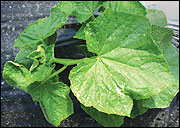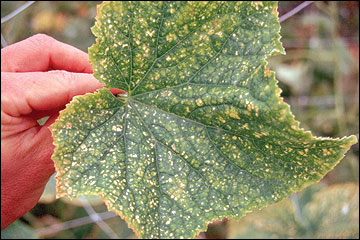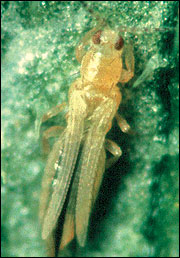Thrips



Figure 22.
Thrips cause significant foliar damage to cucurbits, top and bottom left. Adult thrips, greatly enlarged, bottom right.
Thrips (Thysanoptera: Thripidae) are small (1/16 inch long) elongated insects that can be a serious insect pest of high tunnel melons and watermelons. Thrips are usually found clustered in flowers and on the underside of leaves, especially near the terminal growth of the vines. Damage to the plants is caused by adult and nymph thrips scraping the surface of the leaves with their mouthparts and feeding on the exuding sap. The damaged plants will have small, silver streaks on the leaves, and the plant looks as though it has been sandblasted (Figure 22). Fruit can have surface scars from early-season thrips feeding. Thrips, like aphids, can be imported into the high tunnel on transplants.
Always isolate vegetable transplants from ornamental plants in the greenhouse. Early detection of thrips is important. Inspect plants regularly, looking in blossoms or on the underside of terminal leaves. Use blue sticky traps to detect winged adult thrips.
Minute pirate bugs (Orius insideosus), green lacewings and predatory mites are natural enemies of thrips and may be effective in the early stages of a thrips invasion.
However, using beneficial insects and mites will not be effective as a rescue treatment for widespread thrips invasion within the high tunnel. Systemic, targeted insecticides applied at transplanting will be effective in controlling thrips for about 35 days.
Several soft pesticides may be used to control thrips within a high tunnel. Insect exclusion screen can be used to cover the high tunnel vents and prevent invasion of thrips.